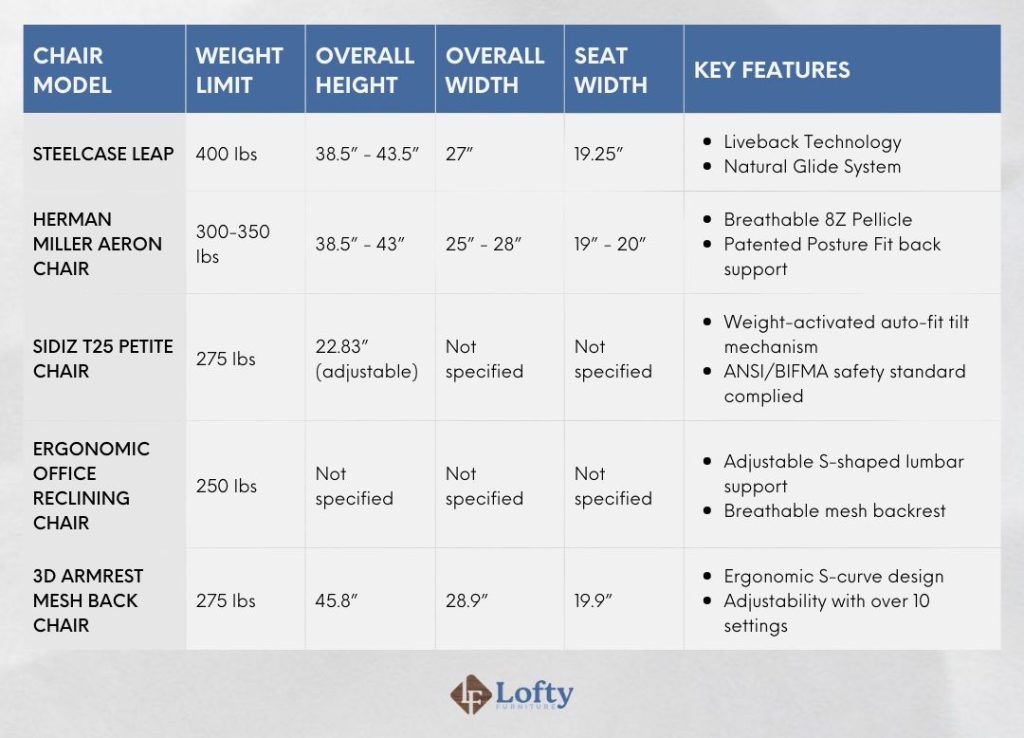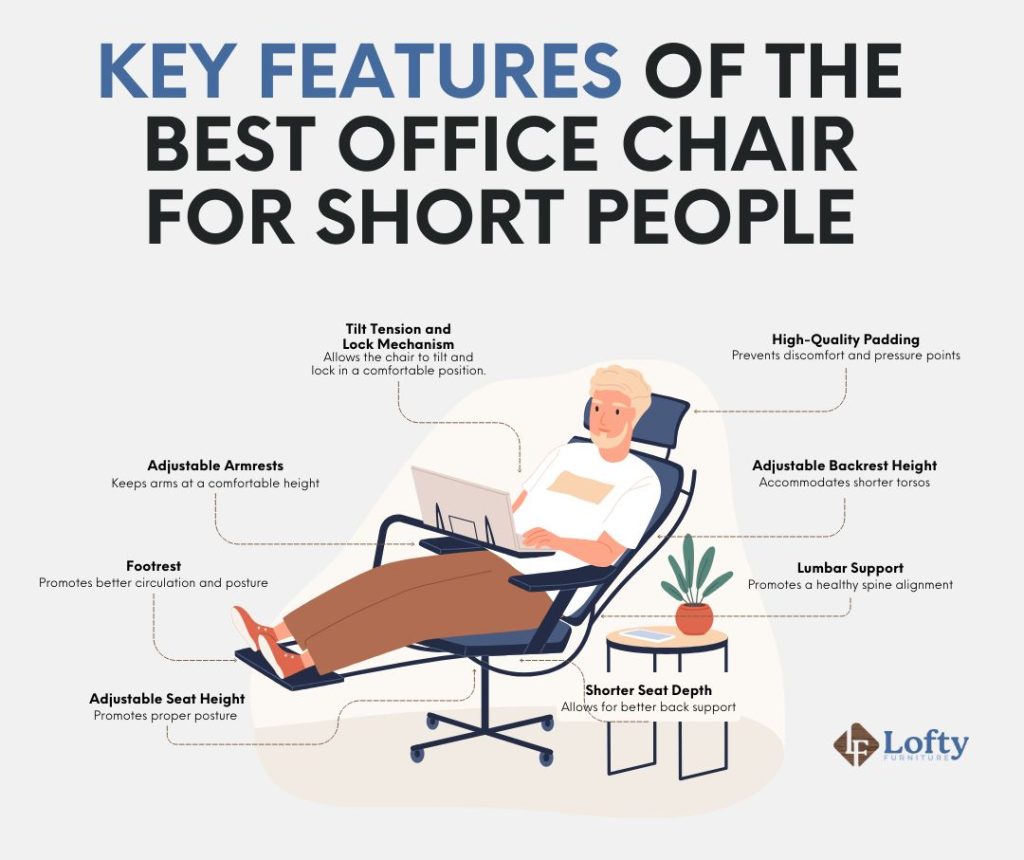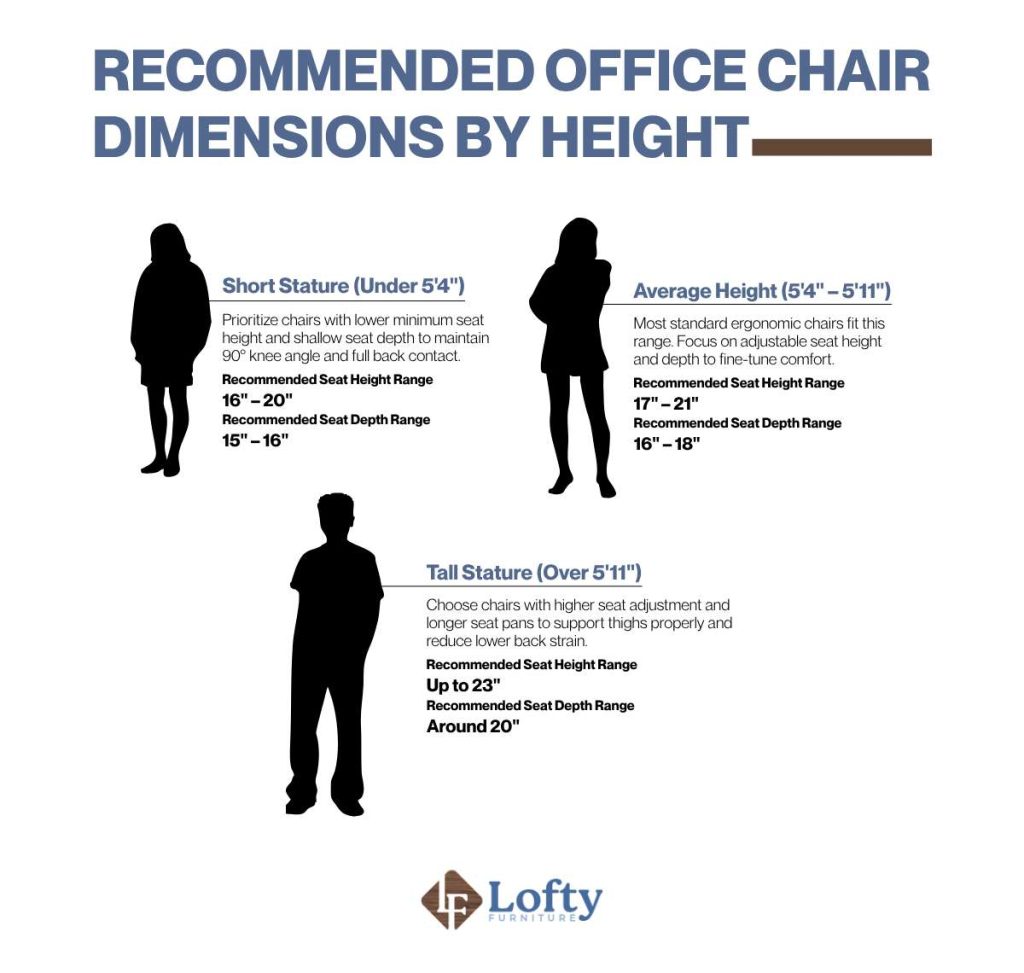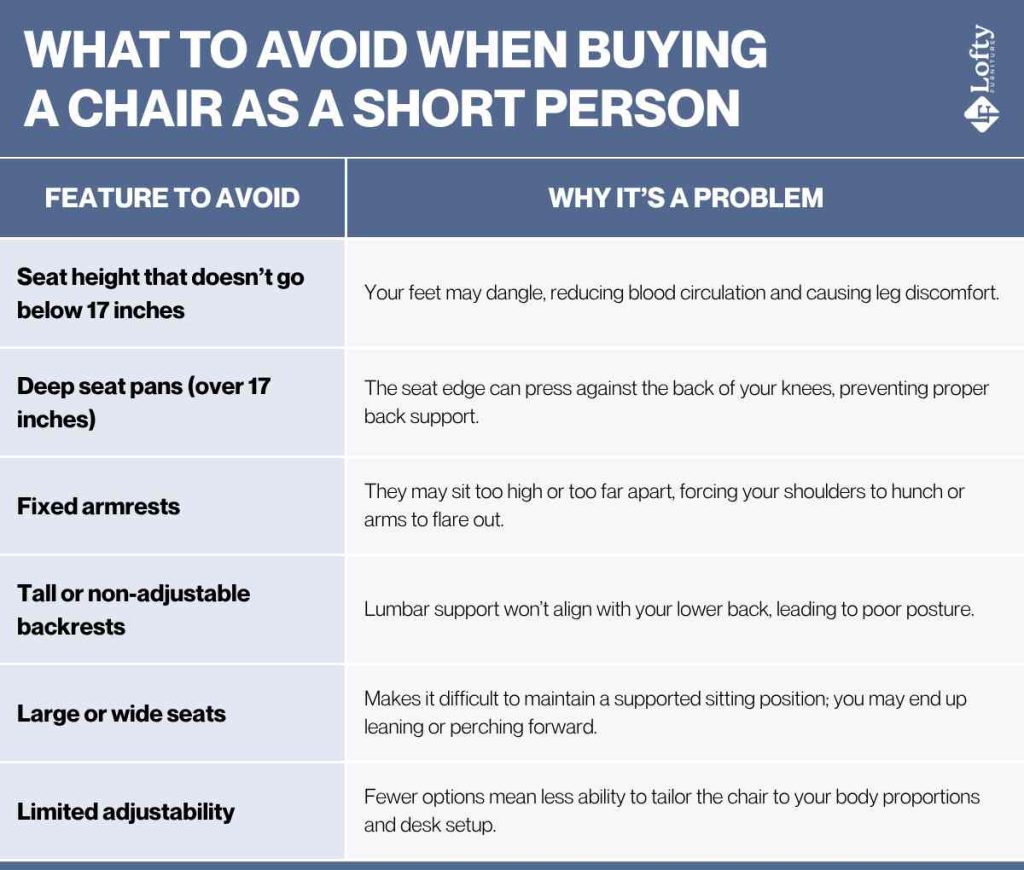Standard office chairs are often designed for average-sized adults, leaving shorter individuals dangling their feet or hunching over to reach the armrests. This not only feels uncomfortable, but it can also lead to back pain and other musculoskeletal issues. The good news is, there are best office chair designed specifically for shorter person! These chairs prioritize adjustability and ergonomics to ensure a comfortable and supportive fit.
Key Takeaways
- The best office chairs for short people offer adjustable seat height and depth, lumbar support, and armrests to promote proper posture and reduce discomfort.
- Avoid oversized chairs and always check if the design suits shorter body types.
- DIY fixes like footrests or lumbar cushions can improve comfort if a new chair isn’t an option.
This guide explores the top 5 office chairs that cater to the needs of petite individuals, keeping your comfort and posture a priority throughout your workday.
Why Ergonomics Matter for Short People

Ergonomics is the science of designing workplaces, tools, and furniture to suit the user’s body and capabilities. This is especially important for shorter individuals, as standard office furniture often doesn’t accommodate smaller statures. Poorly adjusted chairs and desks can lead to improper posture, reduced circulation, and conditions like carpal tunnel syndrome. For example, if chairs are too high or lack adequate lumbar support, shorter people may hunch their backs to reach armrests or keyboards, straining the spine and leading to lower back pain, neck pain, and headaches. Similarly, if keyboards or mice are positioned too high, it can force the wrists into awkward positions, increasing the risk of carpal tunnel syndrome.
A 2021 study in the Journal of Occupational Health found that office workers with non-ergonomic workstations were significantly more likely to experience neck and shoulder pain compared to those with ergonomically designed setups. Investing in an ergonomic chair that fits your body properly can greatly improve your comfort and reduce the risk of pain and injury.
Top 5 Office Chairs for Short People
Finding the right chair is essential for maintaining comfort and productivity, but for shorter individuals, this can be a particularly daunting task. Let’s explore the best options to find your ideal seating solution!

1. Steelcase Leap Chair

The Steelcase Leap Chair is a favorite for anyone looking to fully customize their sitting experience—especially great for shorter folks. It’s packed with features like adjustable armrests, lumbar support you can tweak for firmness and position, and seat depth controls. The standout LiveBack technology adapts to your spine’s natural shape, while the Natural Glide system lets you recline without losing sight of your screen or desk.
Pros:
- LiveBack technology for spinal support
- Reclines without shifting you away from your desk
Con:
- High price
2. Herman Miller Aeron Chair

The Aeron Chair has built its legendary status for a reason. It’s not only breathable—thanks to its unique 8Z Pellicle mesh—but also promotes posture with features like the PostureFit support system that aligns your back and pelvis. You can adjust pretty much everything, and it comes in three sizes (including one well-suited for shorter users), so getting the right fit is easy.
Pros:
- Breathable mesh for temperature control
- Size options and full adjustability
Con:
- Expensive
3. SIDIZ T25 Petite Ergonomic Office Chair

Made with shorter users in mind (as short as 4’9″), the SIDIZ T25 Petite offers a compact, modern design with surprisingly smart features. Its standout is a weight-activated tilt that auto-adjusts as you move, so you don’t have to fiddle with it constantly. The chair also has adjustable seat height, a mesh back for airflow, and meets durability standards—all while supporting up to 275 lbs.
Pros:
- Designed for petite frames (4’9″+)
- Auto-adjusting tilt mechanism
Con:
- Fewer manual adjustment options
4. Ergonomic Office Reclining Chair

If you’re budget-conscious but still want ergonomic benefits, this reclining chair is a solid pick. It includes S-shaped lumbar support for your lower back, breathable mesh for comfort, and a rocking function that lets you shift between focused work and relaxed breaks. Flip-up 2D armrests and adjustable height help shorter users stay comfy and aligned.
Pros:
- Affordable price point
- Reclining function to relieve fatigue
Cons:
- Limited adjustability compared to premium chairs
5. 3D Armrest Mesh Back Computer Chair Seat

With over 2 million units sold globally, this mesh chair blends style and function. Its ergonomic S-curve design supports your spine, and it offers over 10 adjustment settings for a custom fit—great for shorter users around 5’1″ and up. It’s also won awards for its sleek look and provides solid lumbar support with a breathable back.
Pros:
- Ergonomic S-curve spine support
- Over 10 adjustable settings
Con:
- Lacks detailed adjustment info
Don’t let your feet dangle! Find the perfect modern ergonomic chair designed to fit a shorter stature and offer all-day comfort.
Key Features of the Best Office Chair for Short People
Finding the right, comfortable chair is crucial for everyone’s comfort and well-being, but it’s especially important for shorter individuals. Here are the key features to prioritize when choosing an office chair for a short person:
1. Adjustable Seat Height and Depth: This allows you to adjust the chair for a comfortable seating position with your feet flat on the floor and knees bent at a 90-degree angle. Ideally, the seat depth should allow for a slight gap between the back of your knees and the chair seat.
2. Lumbar Support: A properly designed lumbar support should cradle your lower back and maintain its natural curve. This helps to reduce slouching and promotes proper spinal alignment, leading to less back pain and discomfort.
3. Adjustable Armrests: Armrests that adjust in height and width allow you to find a comfortable position for your arms and shoulders. Ideally, your arms should rest comfortably on the armrests with your shoulders relaxed and not reaching upwards.
4. Seat Width and Depth Considerations: A seat depth of 15-16 inches is ideal for shorter individuals, allowing you to sit back comfortably without placing undue pressure on the backs of your knees.
5. Importance of Tilt Tension and Control: Tilt tension allows you to adjust the amount of effort required to recline the chair. This is important for maintaining proper posture and core engagement throughout the day.

How to Choose the Right Office Chair for Your Height
Finding the perfect office chair requires more than just aesthetics or brand name. Here’s a guide to help you navigate the selection process:
1. Measure Your Body Dimensions
To find a chair that fits your needs perfectly, start by knowing your key body dimensions. First, measure your height by standing straight against a wall with your feet bare, and record the distance from the floor to the top of your head. Next, determine your inseam by standing with your back to the wall, placing a book between your legs at your crotch level, and marking the wall where the top of the book meets. Measure the distance from the floor to this mark. Finally, to gauge your torso length, sit in a chair with your back straight and measure from the base of the seat to your shoulder height.
Here’s a great video to watch before you shop:
2. Know the Right Chair Specifications for You
Once you have your measurements, you can start understanding chair specifications. Seat height is the distance from the floor to the seat’s surface at its lowest setting. Seat depth measures the distance from the front edge of the seat cushion to the backrest. Armrest height refers to the distance from the floor to the top of the armrests. Additionally, some chairs come with adjustable lumbar support, allowing you to move it up or down to match the curve of your lower back.
If you’re still unsure, you can consider what the experts say. Ergonomics experts recommend the following when choosing an office chair for your height:

You might be interested to learn about the benefits of using cross legged office chair.
Mistakes Short People Should Avoid When Buying a Chair
When shopping for an office chair as a shorter person, it’s easy to make choices that compromise comfort and posture in the long run. One common mistake is focusing only on price. While budget-friendly chairs might seem like a great deal, they often lack proper adjustability, leading to discomfort or even posture-related pain over time. Another major error is ignoring ergonomic features. For shorter users, it’s especially important to look for chairs with a low seat height range, shallow seat depth, adjustable armrests, and proper lumbar support.
Finally, overlooking user reviews can lead to regret. Customer feedback often reveals whether a chair truly accommodates smaller frames and how it performs over time. Paying attention to reviews written by users of similar height can give you valuable insight into real-world comfort, durability, and fit—helping you make a confident, informed purchase.

If you can’t afford a brand new ergonomic chair, there are some simple DIY adjustments you can make to your current chair to improve your comfort and posture:
1. Using Footrests: Footrests elevate your feet, taking pressure off your legs and improving circulation. This can help to reduce fatigue and discomfort, especially for shorter individuals who may not be able to place their feet flat on the floor with a standard chair height.
2. Adding Cushions: A lumbar support cushion placed behind your lower back can fill the gap and provide additional support for your spine’s natural curve.
3. Adjusting Desk Height (if possible): Ideally, your desk and chair should work together to create a comfortable and ergonomic workstation. If your desk dimension is adjustable, you may be able to raise it slightly to achieve a better fit with your chair.
Conclusion
Choosing the right office chair is an investment in your health and well-being. Sitting for extended periods in a chair that doesn’t fit your body can lead to a variety of problems. This includes back pain, fatigue, and poor circulation. By prioritizing ergonomic features and adjustability when selecting a chair, you can create a comfortable and supportive workspace that keeps you productive throughout the day.
Remember, you spend a significant portion of your day at your real wood adjustable desk, so investing in a good chair is an investment in your long-term health and productivity.
Frequently Asked Questions (FAQs)
What is the best seat height for a short person?
Experts recommend a seat height range of 16″ to 20″ for short individuals (under 5’4″). This allows you to sit with your feet flat on the floor and knees bent at a 90-degree angle.
Are gaming chairs good for short people?
While some gaming chairs offer good adjustability, they may not provide the ideal fit for shorter people. Look for a chair specifically designed for ergonomics and short stature to ensure proper support.
How can I make my current chair more comfortable?
There are several DIY adjustments you can make to improve your current chair’s ergonomics, such as using a footrest, adding cushions (lumbar and seat), or raising your desk height (if possible).
Can I return or exchange a chair if it doesn’t fit?
Most reputable retailers offer return or exchange policies within 30 days, but check the fine print. Keep all packaging until you’re sure the chair fits, and verify whether the return covers shipping costs or restocking fees.
I’m under 5 feet tall. Are there any office chairs that will fit me?
Yes. Look for chairs with a seat height as low as 15–16 inches and a shallow seat depth (around 15 inches). Models like the Herman Miller Aeron Size A and Steelcase Leap v2 are designed specifically to fit smaller users comfortably.
